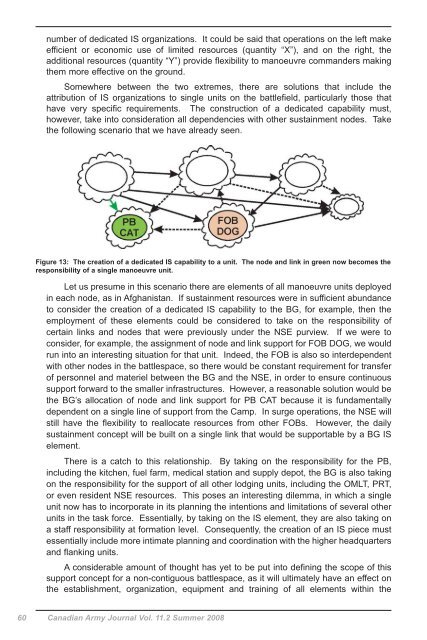Practical Sustainment Concepts for the Non-Linear Battlespace
Practical Sustainment Concepts for the Non-Linear Battlespace
Practical Sustainment Concepts for the Non-Linear Battlespace
Create successful ePaper yourself
Turn your PDF publications into a flip-book with our unique Google optimized e-Paper software.
number of dedicated IS organizations. It could be said that operations on <strong>the</strong> left make<br />
efficient or economic use of limited resources (quantity “X”), and on <strong>the</strong> right, <strong>the</strong><br />
additional resources (quantity “Y”) provide flexibility to manoeuvre commanders making<br />
<strong>the</strong>m more effective on <strong>the</strong> ground.<br />
Somewhere between <strong>the</strong> two extremes, <strong>the</strong>re are solutions that include <strong>the</strong><br />
attribution of IS organizations to single units on <strong>the</strong> battlefield, particularly those that<br />
have very specific requirements. The construction of a dedicated capability must,<br />
however, take into consideration all dependencies with o<strong>the</strong>r sustainment nodes. Take<br />
<strong>the</strong> following scenario that we have already seen.<br />
Figure 13: The creation of a dedicated IS capability to a unit. The node and link in green now becomes <strong>the</strong><br />
responsibility of a single manoeuvre unit.<br />
Let us presume in this scenario <strong>the</strong>re are elements of all manoeuvre units deployed<br />
in each node, as in Afghanistan. If sustainment resources were in sufficient abundance<br />
to consider <strong>the</strong> creation of a dedicated IS capability to <strong>the</strong> BG, <strong>for</strong> example, <strong>the</strong>n <strong>the</strong><br />
employment of <strong>the</strong>se elements could be considered to take on <strong>the</strong> responsibility of<br />
certain links and nodes that were previously under <strong>the</strong> NSE purview. If we were to<br />
consider, <strong>for</strong> example, <strong>the</strong> assignment of node and link support <strong>for</strong> FOB DOG, we would<br />
run into an interesting situation <strong>for</strong> that unit. Indeed, <strong>the</strong> FOB is also so interdependent<br />
with o<strong>the</strong>r nodes in <strong>the</strong> battlespace, so <strong>the</strong>re would be constant requirement <strong>for</strong> transfer<br />
of personnel and materiel between <strong>the</strong> BG and <strong>the</strong> NSE, in order to ensure continuous<br />
support <strong>for</strong>ward to <strong>the</strong> smaller infrastructures. However, a reasonable solution would be<br />
<strong>the</strong> BG’s allocation of node and link support <strong>for</strong> PB CAT because it is fundamentally<br />
dependent on a single line of support from <strong>the</strong> Camp. In surge operations, <strong>the</strong> NSE will<br />
still have <strong>the</strong> flexibility to reallocate resources from o<strong>the</strong>r FOBs. However, <strong>the</strong> daily<br />
sustainment concept will be built on a single link that would be supportable by a BG IS<br />
element.<br />
There is a catch to this relationship. By taking on <strong>the</strong> responsibility <strong>for</strong> <strong>the</strong> PB,<br />
including <strong>the</strong> kitchen, fuel farm, medical station and supply depot, <strong>the</strong> BG is also taking<br />
on <strong>the</strong> responsibility <strong>for</strong> <strong>the</strong> support of all o<strong>the</strong>r lodging units, including <strong>the</strong> OMLT, PRT,<br />
or even resident NSE resources. This poses an interesting dilemma, in which a single<br />
unit now has to incorporate in its planning <strong>the</strong> intentions and limitations of several o<strong>the</strong>r<br />
units in <strong>the</strong> task <strong>for</strong>ce. Essentially, by taking on <strong>the</strong> IS element, <strong>the</strong>y are also taking on<br />
a staff responsibility at <strong>for</strong>mation level. Consequently, <strong>the</strong> creation of an IS piece must<br />
essentially include more intimate planning and coordination with <strong>the</strong> higher headquarters<br />
and flanking units.<br />
A considerable amount of thought has yet to be put into defining <strong>the</strong> scope of this<br />
support concept <strong>for</strong> a non-contiguous battlespace, as it will ultimately have an effect on<br />
<strong>the</strong> establishment, organization, equipment and training of all elements within <strong>the</strong><br />
60 Canadian Army Journal Vol. 11.2 Summer 2008







![La modularite dans l'Armee de terre canadienne [pdf 1.6 MB]](https://img.yumpu.com/17197737/1/188x260/la-modularite-dans-larmee-de-terre-canadienne-pdf-16-mb.jpg?quality=85)









